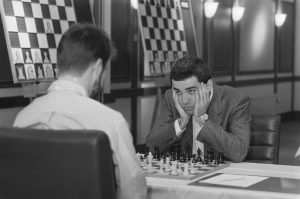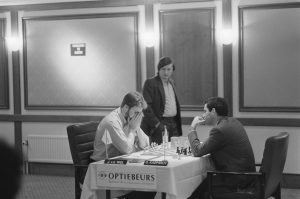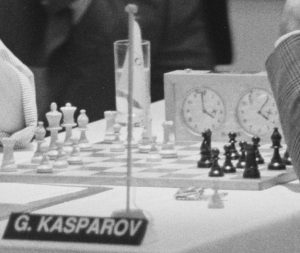
Kasparov: 1.e4….. Doesn’t he know what will now come upon him?
If you have grasped the logic of an opening or variation, you have a good idea of its winning potential. The following overview is not exhaustive, but still provides you with a good notion of the most important principal winning ideas for Black in the Deep Sicilian. In order to get a clearer picture, it makes sense to structure the roads to victory in different main categories. I chose to establish four of them, but this is just my convention and other arrangements are possible as well.
Please note that I have to present this list in a very concentrated form, without giving explicit examples, due to the lack of space. Most of the following points could easily fill a two days seminar, some of them entire books. If I would present example games, we would need one blog post per category. Of course, this would go against my intention to present a variety of topics, to accomodate to the different interests of my readers. Also note that this categorization is not supposed to teach you how to play the Sicilian (it might be one important part of the entire mosaic, though), but is meant to back the legitimacy of the term “Deep Sicilian” for this specific structure, by presenting the sheer amount of ideas. At the same time, this listing might serve you as an example for working with this kind of overviews for openings in general.
a) Active-Dynamic
1.Attack in positions with opposite castling
This is a huge category, as opposite castling is a wide spread phenomenon in the Sicilian. In many variations both sides go for a direct attack on the enemy king. In such a race-like situation, not wasting time is of highest importance, but it also pays to find efficient prophylactic measures, in order to slow down the opponent’s assault.
2. Direct Attack against the kingside castle
It happens, but not too often, that Black engages in a direct attack on the kingside castle, as normally White starts out with a lead in development and space advantage on the kingside. However, there are setups in the Paulsen structure, where Black bets on active and direct piece play, involving moves such as b7-b5, Bb7, Bc5, Qc7, h5-h5, Ng4 etc.
3. Counter attack in the Centre
That’s an important category again. As the general guideline is to meet an attack on the flank by a counter strike in the centre, it doesn’t come as a surprise that Black likes to answer a white pawn storm on the kingside with d6-d5 or e6-e5 (fixing the pawn e4), followed by d6-d5. In many cases, this brings the attack to a halt and leaves White with a weakened structure or misplaced pieces.
4. Tactical tricks
Black has some tactical tricks available, often based on weaknesses along the diagonal a7-g1. A banal one is to pick up the b-pawn with Qb6+, followed by Qxb2.
5. Direct play against the exposed e4-pawn
The most exposed piece (= natural weakness) on the Sicilian chess board is the pawn e4. Once White has played f2-f4, which happens quite often, it cannot be supported by a pawn anymore. Black can then aim many weapons on it: Nf6, Bb7, Nbd7-c5, Qa8 and Rc4.
6. Indirect play against the exposed e4-pawn by pushing the b-pawn.
An important strategic device is to attack the natural defender of the e-pawn, the Nc3, by means of b7-b5, followed by b5-b4. If White stops it with a3, Black can keep on insisting with a5. The power of pushing the pawn to b5 lies in the fact that it can often be done even if the pawn is numerically underdefended (let’s say Pa4 and Nc3 against Pa6), exploiting the fact that the Nc3 might be overloaded. Taking Black’s b-pawn would then equate to abandoning the e-pawn, which is clearly the more valuable asset.
7. Indirect play against the exposed e4-pawn by sacrificing the exchange on c3
The exchange sacrifice on c3 is standard. Crippling White’s structure and getting hold of the e-pawn in return for a small material investment is a very good deal for the black player most of the time, as it gives him dominance in the centre and play in the c-file, while at the same time depriving White’s structure of all its dynamic potential.
8. Pushing b5 as a sacrifice
In Hedgehog structures with a pawn on c4, b7-b5 can sometimes by executed as a pure sacrifice in the style of the Wolga-Benko-Gambit. Black receives a lot of space on the queenside, play against the pawns on a2 and b2 and the possibility to expand with d6-d5. White’s position in return is overstretched. With such a broad front line and the centre unstable, it is impossible for him to focus on kingside activities.
9. Pushing d5 as a sacrifice
Sacrificing the d- pawn is also very common in the Hedgehog structure. The most famous example might be the legendary game Karpov-Kasparov, Moscow 1985.
10. Attacking the b2-c3 complex
The dependence of the Nc3 on its protection by the b2-pawn, provides a lot of strength to the natural knight manoeuvres Nc6(d7)-e5-c4, Nc6-a5-c4 or Nd7-b6-c4. Playing b2-b3 would then unroot the Nc3 and defending the pawn by means of Rb1 could often be answered by Nxb2 / Rxb2 Q(R)xc3. In positions with a pawn on a3, Nxa3 or Bxa3 might work, as the pawn b2 is overloaded. With his queen on c7 Black might even play the aesthetic move Ba3, which can be very annoying for White, let’s say with his king still on e1 and his bishop on e3.

Karpov: There is no denying. What Garry does is a bit more exiting than my Caro-Kann.
b) Active-Static
This category needs some explanation, especially as activity appears to be rather a dynamic and not a static phenomenon. But in chess things are almost never easy or clear-cut. There are always different layers and perspectives, which render the boundaries between dynamic and static pretty fluent. Indeed, there is room for different kinds of definitions, depending on where you want to put the emphasis on. I decided to list activities here, which are of easy going, automatic nature or which occur in the realm of static values.
11. Inflicting a pawn weakness
Inflicting a pawn weakness can be brought about by exchanges or pawn breaks. Both can be considered as dynamic actions, but yet it happens within the context of the pawn structure, which belongs to the static sphere. One example is the pawn thrust e6-e5, followed by exf4, leaving the e4-pawn weak. More important, however, is the Sicilian minority attack on the queenside, which sometimes results in an isolated white b-pawn or other weaknesses.
12. Counter attack against the weakened king’s position
This could have also been subordinated under “a) Active-Dynamic”, as attacking the king apparently is a dynamic action. For my purposes, however, the static element is more important. By playing f2-f4 with his king on g1, White inflicts an irreparable long-term weakness to his king’s position. This is a stable, static element, which is only mitigated when the queens leave the board. However, even then it doesn’t completely disappear, if you think about the Bb7 and an invaded rook on c2 converging on the neuralgic point g2.
Of course, this weakness becomes much more dramatic once White decides to go after Black’s king by means of g2-g4. While this is often justified and sometimes even very strong, it might very well backfire, if White’s attack gets stuck or if Black manages to open lines against White’s king by pushing d6-d5.
13. Exploiting the “backward” c2 pawn.
The pawn c2 can also be considered as a weakness, as it is located in Black’s most important area of activity – the semi-open c-file. Under normal conditions, the pawn could simply move to c3. But here it is impeded by the Nc3, which occupies an important position and cannot simply move away. What sometimes happens is that Black doubles major pieces in the c-file, thus making it even more difficult for the Nc3 to move. Then, Black will try to chase the knight by playing b5-b4, directly targeting the pawn c2. I attribute this pawn some of the qualities of a backward pawn, as it is unable to move and thus subject to be attacked. Hence, this winning idea is labeled as “static”.
14. Gaining space advantage on the queenside
By pushing his pawn to b4, Black normally manages to considerably expand his sphere of influence and provides his pieces with a lot of space to work with. In some instances, Black continues with moving his a-pawn to a4, which could lead to a minority attack after a subsequent b4-b3 (see above). In the course of this expansion, Black’s heavy pieces might find a strong square on a5 and the bishop could be developed to a6.
15. Central thrust d6-d5
I already mentioned the pawn break d6-d5 in the context of countering a white attack on the kingside. The present context is a more static one, as it is independent of White’s actions on the wing. By defining the position as an Open Sicilian with d4 cxd4, which normally happens on move 3, Black comes into possession of the central pawn majority, which is an important static asset. As a consequence, Black has a good central control with his pawns on e6 and d6. If the circumstances are right, however, he can use his asset in a more active way, by advancing his pawns. Of course, pushing d6-d5 is easier, once the Nc3 had been chased away by b5-b4 (see previous topic). This is a good example for the interconnectedness of all things which happen on the chess board. Without a white knight on c3, Black will often end up with a monster knight on d5 after d6-d5 / exd5 Nxd5. An important aspect of this change of structure is that White’s pawns lose their dynamism. Additionally, weak squares pop up on e4, e3 and g4 and the now very active black pieces have a range which reaches deep into the heart of White’s fortress (pawn g2).
16. Playing on the dark squares by conquering the square e5 with e6-e5
Controlling or dominating important squares or an entire color complex can provide you with an important positional advantage. As White has more pawn presence on the white squares (pawns on a2, c2 and most importantly e4), it is his black squares which might become potentially weak and where Black might be looking for play. One device is the thrust e6-e5, followed by exf4 (or by recapturing on e5 with a piece, should White take there). Now, the square e5 can be used as an outpost for the knight or any other piece. It goes without saying that this change of structure also vitalizes the Be7, which can now be transferred to f6.
17. Playing on the dark squares by conquering the square e5 with g7-g5
A rarer and extremely sophisticated device to conquer the square e5 is the move g7 g5. The problem with e6-e5 is that White might answer f4-f5, leaving the square e5 occupied by a pawn. If Black plays e6-e5 before White has put his pawn on f4, White might as well refrain from doing so, thus keeping Black’s pieces obstructed and the square d5 potentially weak. In case of g7-g5, however, f4-f5 surrenders the square e5 to Black’s knight and also the bishop will profit by finding an active place on f6. Black’s move has also to be considered in the context of destroying White’s dynamic potential. Especially if White advances with the phalanx e4, f4, g4, removing the centre pieces (the pawn f4), very often brings White’s attack to a complete standstill.
18. Dominating the dark squares by sacrificing the pawn d6
In some position White plays Bg5xf6, either forcing Black to accept a rigid structure after gxf6 or abandoning the d-pawn after Bxf6 / Q(R)xd6. What way of recapturing is better depends on the specific characteristics of the position, but more often than not, abandoning the d-pawn by playing Bxf6 gives Black enough compensation, due to his superiority on the dark squares.
19. Dominating the dark squares by sacrificing the exchange
Sacrificing a rook for the dark-squared bishop is a common motif in the Dragon Variation, but that is not our topic. In the Deep Sicilian, there is less opportunity to do so, but it also happens. I know several examples from the Hedgehog, where Black moves the rook to c5 and doesn’t care to move it away should it happen to be attacked by Be3 or even captures a bishop on g5 with his rook. In both cases, however, White had already weakened his dark-squares by moving his pawns to f3 and g4.
20. Dominating the light squares
Obtaining the upper hand on the light squares is more difficult to achieve, but it can happen when three things fall together: 1) White plays f4 2) Black exchanges his knight for the light-squared bishop on the squares d3, b3 or c4. 3) White plays e4-e5, voluntarily or forced. I will give one typical example: Black plays Nc6-b4xd3 (capturing the bishop). White answers cxd3 (strengthening the centre). Now, Black uses the lever d6-d5 in order to soften White up on the light squares. White answers e4-e5, with the intention to either follow-up with d3-d4 or Nf3-d4 or Be4-d4, in all cases condemning the Bb7 to stare at the d5 pawn. But know, Black sacrifices a pawn with d5-d4 and suddenly all his pieces spring to live: The Bb7 turns into a monster on the long diagonal, the major pieces find work along the d-file and the knight is happy to occupy a nice outpost on d5. A different example for a light square-strategy is the exchange sacrifice on c3, followed by Nxe4 and further f7-f5, cementing the outpost e4.
21. Defensive Sacrifices
The logic of the defensive sacrifice is easy to explain. The attacker often weakens his pawn structure, which not only creates weak pawns and weak squares, but sometimes even exposes the king. In positions where the attack relies on transferring pieces into the vicinity of the enemy king, these pieces would be poorly placed if the attack would come to a halt. Hence, sacrificing material to stop the attack will be compensated by the above mentioned adversities.
As an example I want to mention the queen sacrifice, most often for a rook and a minor piece (sometimes a pawn, as well). After the sacrifice the position turns from dynamic to static and as we know, the queen doesn’t perform too well in static positions where there is not much to attack.

5..a6 or 5..e6? Kasparov played both moves against Van der Wiel.
c) Passive-Static
This sub-category refers to cases, where White “kills himself”.
22. Winning material when White sacrifices incorrectly or follows through poorly
In many lines White is more or less forced to attack, in order to exploit his dynamic advantages (lead in development and unstable space advantage). Sometimes this requires to burn the bridges by weakening the position or by sacrificing. Actually, sacrificing sometimes is a consequence of irrevocable pawn moves or committal piece allocations. As White might be positionally lost in case the attack gets stuck, he might as well fuel it by throwing material into the oven. In that case Black only has to ward of the onslaught, in order to capitalize on his material advantage.
23. Exploiting structural weaknesses in the wake of a white attack
Black doesn’t need material gains to win the game. Often, weak pawns and weak squares are fully sufficient to win the endgame. It goes without saying that committal pawn moves such as e4-e5, f4-f5, g4 or h4 cause irreparable weaknesses. If the attack succeeds – who cares? But if not, pay day will come for Black. Here just one example: Often White plays e4-e5 and after dxe5 / fxe5 he has gained space and Black’s position might be a little cramped. But what happens, if Black manages to exchange a couple of minor pieces and liberate his game? Right, the weakness of White’s e-pawn will start to tell.
d) Long-term – Static
24. Bishop pair
As White’s position is more advanced, so is the position of his bishops. This exposure leads to many situations, where exchanges of a black knight for a white bishop might take place. Here are the typical constellations: 1) Black plays Nc6-b4xd3 2) Black plays Nc6(d7)-e5xd3 3) Black plays Nc6-a5xb3 4) Black plays Nc6-a5-c4 or Nc6-e5-c4 or Nd7-b6-c4 and White captures the knight with his bishop 5) Black plays Nf6-g4xe3 6) Black play h6, White answers Bxf6 7) Black plays h6, White answers Bh4, Black plays g5 / Bg3 Nh5xg3. Possessing the bishop pair is a considerable material advantage which makes itself felt in open and half open middle game positions and in almost every ending.
25. Playing the “perfect strategic Sicilian ending”
I use the term “perfect strategic Sicilian ending” for the following (not all of the elements have to exist, though): Queens and at least two minor pieces have been exchanged. Black’s king has a comfortable and useful place on e7, defending the pawn d6. One rook is placed on the c-file. He expands on the queenside with b5 and on the kingside with g5 and maybe h5. His knight might be placed on e5. That’s a situation where Black controls the entire board without taking any risks.
Conclusion
While this list is not exhaustive, it yet gives you a good idea of the richness of the Deep Sicilian and the abundance of distinct winning ideas. It is this quality that makes it so popular with ambitious players, who strive to grab the full point from their opponents despite being Black. There are many ways for Black to enter a Deep Sicilian. Without doubt the Najdorf Variation is the capo di tutti capi. But it is very high maintenance, if you only consider the lines 6.Bg5 and 6.Be3. The Scheveningen is less sharp, but here Black has to deal with the Keres Attack. In the Classical System Black still didn’t prove equality against the Richter-Rauzer Attack, according to my knowledge. The Kan Variation is interesting, but the road to equality is very thin after 5.Bd3. The Paulsen Variation is one of the most solid options. Here, Black can sometimes transpose to the Scheveningen, but has already committed to a setup with Qc7. One advantage of the Four Knights is the ability to tap into the immense winning potential of the Deep Sicilian, if given the chance by White’s response on move 6, for instance after 6.Be2, 6.a3 or after lesser alternatives. In any of this cases, Black will enjoy instant equality.
